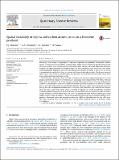Files in this item
Spatial variability of tephra and carbon accumulation in a Holocene peatland
Item metadata
| dc.contributor.author | Watson, E.J. | |
| dc.contributor.author | Swindles, G.T. | |
| dc.contributor.author | Lawson, I.T. | |
| dc.contributor.author | Savov, I.P. | |
| dc.date.accessioned | 2015-08-11T09:10:04Z | |
| dc.date.available | 2015-08-11T09:10:04Z | |
| dc.date.issued | 2015-09-15 | |
| dc.identifier | 208918782 | |
| dc.identifier | f6b3f4f1-d3a2-4b92-b159-3ab4dcb92d81 | |
| dc.identifier | 84939147666 | |
| dc.identifier | 000361258000013 | |
| dc.identifier.citation | Watson , E J , Swindles , G T , Lawson , I T & Savov , I P 2015 , ' Spatial variability of tephra and carbon accumulation in a Holocene peatland ' , Quaternary Science Reviews , vol. 124 , pp. 248-264 . https://doi.org/10.1016/j.quascirev.2015.07.025 | en |
| dc.identifier.issn | 0277-3791 | |
| dc.identifier.other | RIS: urn:5A90185783C1FFA3487E6CCC28CD6B6E | |
| dc.identifier.other | ORCID: /0000-0002-3547-2425/work/75996905 | |
| dc.identifier.uri | https://hdl.handle.net/10023/7181 | |
| dc.description | This research was undertaken while Elizabeth Watson was in possession of a NERC funded Doctoral Training Grant NE/K500847/1. Date of Acceptance: 25/07/2015 | en |
| dc.description.abstract | Microscopic tephra layers (‘cryptotephras’) represent important age-equivalent stratigraphic markers utilised in many palaeoenvironmental reconstructions. When used in conjunction with proximal records of volcanic activity they can also provide information about volcanic ash cloud fallout and frequency. However, the spatial distributions of tephra layers can be discontinuous even within the same region. Understanding the deposition and post-depositional redistribution of tephra is vital if we are to use cryptotephras as records of ash cloud occurrence and chronostratigraphic markers. The discrete nature of tephra layers also allows for detailed study into processes of deposition and reworking which affect many palaeoenvironmental proxy records. We undertook a multi-core study in order to examine the historical tephrostratigraphy of a raised peatland in Northern Ireland. Three tephra layers originating from Iceland (Hekla 1947, Hekla 1845 and Hekla 1510) are present in 14 of the 15 cores analysed. This suggests that in areas not influenced by snowfall or anthropogenic disturbance at the time of tephra delivery, the presence or absence of a tephra layer is generally consistent across a peatland of this type. However, tephra shard counts (per unit area) vary by an order of magnitude between cores. These intra-site differences may confound the interpretation of shard counts from single cores as records of regional ash cloud mass/density. Bootstrap resampling analysis suggests that total shard counts from multiple cores are required in order to make a reliable estimate of median shard counts for a site. The presence of three historical tephras in 14 cores enables a spatio-temporal analysis of the long-term apparent rate of carbon accumulation (LARCA) in the peatland. Substantial spatial and temporal variations in LARCA are identified over the last ∼450 years. This high variability needs to be taken into account when designing studies of peatland carbon accumulation. | |
| dc.format.extent | 17 | |
| dc.format.extent | 2010224 | |
| dc.language.iso | eng | |
| dc.relation.ispartof | Quaternary Science Reviews | en |
| dc.subject | Tephrostratigraphy | en |
| dc.subject | Volcanic ash | en |
| dc.subject | Peatlands | en |
| dc.subject | Geochronology | en |
| dc.subject | Spheroidal carbonaceous particles | en |
| dc.subject | Ireland | en |
| dc.subject | GB Physical geography | en |
| dc.subject | DAS | en |
| dc.subject.lcc | GB | en |
| dc.title | Spatial variability of tephra and carbon accumulation in a Holocene peatland | en |
| dc.type | Journal article | en |
| dc.contributor.institution | University of St Andrews. Geography & Sustainable Development | en |
| dc.contributor.institution | University of St Andrews. Bell-Edwards Geographic Data Institute | en |
| dc.identifier.doi | 10.1016/j.quascirev.2015.07.025 | |
| dc.description.status | Peer reviewed | en |
| dc.identifier.url | http://www.sciencedirect.com/science/article/pii/S0277379115300640#appd001 | en |
This item appears in the following Collection(s)
Items in the St Andrews Research Repository are protected by copyright, with all rights reserved, unless otherwise indicated.

